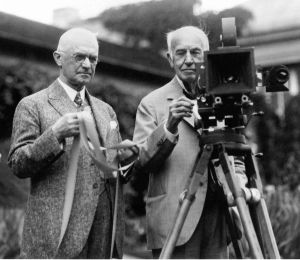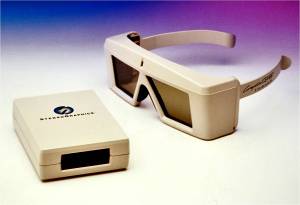 When Edison and Eastman came up with 35mm film – the design of the perforations and the frame — they didn’t make any provision for soundtrack. It’s obvious why –movies were silent in 1895. They came up with a frame aspect ratio whose shape was pretty close to a square – between 1.3:1 and 1.40:1. If I had to guess I’d say they did it because they knew that of any rectangular shape that would fit into the round image created by a lens, a square would make the most effective utilization of the lens’s coverage and 1.3.7 (or whatever it was) was pretty close to square. But 1.37 is, after all, close to a square but a little bit horizontally extended, and people are used to looking at most pictures in what today we call the “landscape mode.” I think most paintings and most photographs are painted or taken in the landscape mode – probably because our eyes are side by side and their field of view favors horizontality. (more…)
When Edison and Eastman came up with 35mm film – the design of the perforations and the frame — they didn’t make any provision for soundtrack. It’s obvious why –movies were silent in 1895. They came up with a frame aspect ratio whose shape was pretty close to a square – between 1.3:1 and 1.40:1. If I had to guess I’d say they did it because they knew that of any rectangular shape that would fit into the round image created by a lens, a square would make the most effective utilization of the lens’s coverage and 1.3.7 (or whatever it was) was pretty close to square. But 1.37 is, after all, close to a square but a little bit horizontally extended, and people are used to looking at most pictures in what today we call the “landscape mode.” I think most paintings and most photographs are painted or taken in the landscape mode – probably because our eyes are side by side and their field of view favors horizontality. (more…)
Archive for March, 2010
THE SHAPE OF SCREENS TO COME
March 25, 2010UPDATE: BRIGHTEST STEREOSCOPIC PROJECTION
March 24, 2010 I have been working on a new stereoscopic projection method, the Oculus3D™ system, using 35mm projectors and specially formatted film. From a business perspective there is a strong demand for a product like this since there are not enough digital projectors, the usual platform for 3D projection, in the United States, North America, or the rest of the world, for that matter. There are theatrical features, mostly adventure fantasy films, shot in 2D, that are being converted so that they can be shown in 3D. And there are 3D movies in the pipeline that were planned to be in 3D — something like two features a month for this year. A studio executive is probably making a good decision to convert assets to maximize attendance and profits after the robust success of Avatar and Alice, which are financial successes that have given a boost to the stereoscopic medium. We are seeing steps toward the ubiquity of the stereoscopic cinema on a genre by genre basis – first kids’ animation, then horror date movies, and now action, science fiction, and adventure films. The 3D films that are getting made are, with the passage of time, for older and older audiences. Now it would seem that all tent-pole movies are likely candidates for 3D. (more…)
I have been working on a new stereoscopic projection method, the Oculus3D™ system, using 35mm projectors and specially formatted film. From a business perspective there is a strong demand for a product like this since there are not enough digital projectors, the usual platform for 3D projection, in the United States, North America, or the rest of the world, for that matter. There are theatrical features, mostly adventure fantasy films, shot in 2D, that are being converted so that they can be shown in 3D. And there are 3D movies in the pipeline that were planned to be in 3D — something like two features a month for this year. A studio executive is probably making a good decision to convert assets to maximize attendance and profits after the robust success of Avatar and Alice, which are financial successes that have given a boost to the stereoscopic medium. We are seeing steps toward the ubiquity of the stereoscopic cinema on a genre by genre basis – first kids’ animation, then horror date movies, and now action, science fiction, and adventure films. The 3D films that are getting made are, with the passage of time, for older and older audiences. Now it would seem that all tent-pole movies are likely candidates for 3D. (more…)
How Shuttering Eyewear Came To Be
March 18, 2010 Field-sequential electro-stereoscopic displays require a selection device to alternately occlude and transmit successive fields to each eye. A sequence of images is written using a technique which is similar to that used for planar video or electronic displays. Today such displays are typically produced by DLP projectors or fast LCDs that are part of TV sets now arriving in retail stores. For a flickerless stereoscopic system, the images need to be written at twice the usual planar 60 fields/second refresh rate, because each eye, independently, needs to see 60 fields/second. Therefore, in most stereoscopic video or computer graphics systems the refresh rate is about 120 fields/second. (more…)
Field-sequential electro-stereoscopic displays require a selection device to alternately occlude and transmit successive fields to each eye. A sequence of images is written using a technique which is similar to that used for planar video or electronic displays. Today such displays are typically produced by DLP projectors or fast LCDs that are part of TV sets now arriving in retail stores. For a flickerless stereoscopic system, the images need to be written at twice the usual planar 60 fields/second refresh rate, because each eye, independently, needs to see 60 fields/second. Therefore, in most stereoscopic video or computer graphics systems the refresh rate is about 120 fields/second. (more…)
Dark Cinema
March 29, 2010This morning, after having driven my three kids to two schools in the San Fernando Valley, I was heading west on Ventura Boulevard when a man in a tank-like black SUV raced toward me on my side of the road. With moments to spare, I swerved out of the way, and you know what? The guy smiled at me and gave me a friendly wave; a grey haired demon, refusing to take responsibility, or just the angel of death trying to do his job? I came home and told Julie what had happened, shouting in outrage. Did it do any good to get excited? Why can’t I view existence with equanimity? I am far from a perfect driver – so live and let live…right? But that’s not who I am and so I move on to the next outrage: a threat to my beloved stereoscopic cinema. (more…)
Posted in 3D Projection, Commentary, Personal, Physics, Stereoscopic | 7 Comments »